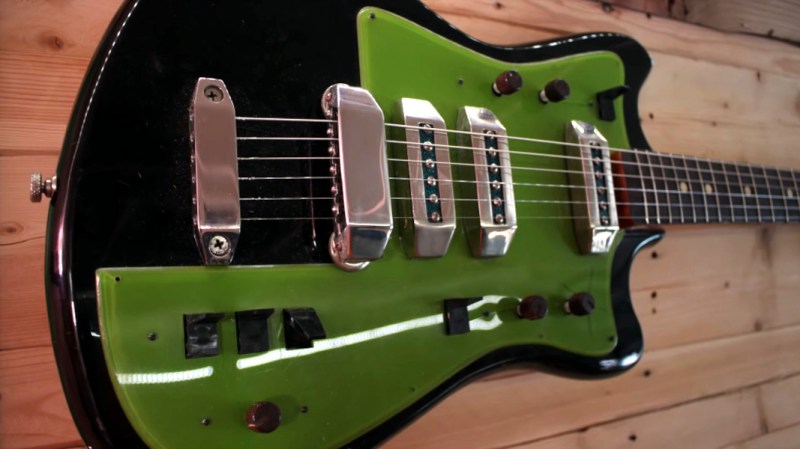What do you do with a cool-looking misfit guitar that has non-working built-in effects and some iffy design aspects? Do you try to fix it and keep it original, or do you gut it and strut your stuff with new bits from around the shop? This is the conundrum that [Tim Sway] finds himself in with this late 70s/early 80s Formanta Solo II straight out of the USSR. (Video, embedded below.)
[Tim] likes a lot of things about it (and we do, too), especially the acid green pick guard, the sparkly pickups, and the beefy bridge that lets him set the string spacing individually, on the fly. It even has a built-in phaser and distortion, but those aren’t working and may never have worked that well at all.

As you can see in the video below, [Tim] has already spent a few hours making it playable and a little more palatable in order to figure out what to do with it electronics-wise. He started by making the 9 V compartment big enough to actually fit a battery inside, and drilled out bigger holes for new tuners.
Interestingly, these guitars had a 5-pin DIN receptacle instead of a 1/4″ jack. [Tim] bought an adapter just in case, but once someone dug up a schematic and sent it over, he decided to rewire it with a 1/4″.
For all of its plus sides, [Tim] doesn’t like the headstock on this thing at all and found the neck to be too chunky for the modern guitarist, so he cut down the headstock, shaved down the neck a bit, and stained it dark. He also made a new nut out of what looks like rosewood. Then it was on to the more standard stuff — file down the frets and polish them, oil the fretboard, and clean up the body.
The point of this exercise is to make a usable guitar for the modern musician. As [Tim] says, this is not a particularly valuable guitar, nor is it rare, and it wasn’t built that well to begin with. One of the issues is the switches — they’re kind of light and cheesy feeling, and one of them is directly in the strum path. Will [Tim] change those out but fix the original effects, or will he make the thing completely his own? We wait with bated breath.
Want to mess around with cheap old guitars, but don’t know where to start? Our own [Sven Gregori] has your back with Axe Hacks.
Via adafruit

















Keep the original!!
If it’s not worth anything, hack it.
Looks like they go from $300-$700 based on condition. This example is probably on the lower end. He is already down the path of modification; I say keep going. I’d try to recreate what it was *supposed* to do originally, with modern electronics and better ergonomics.
My guess is that bridge is for adjusting string *length* not string spacing. This being Hackaday, the answer will inevitably be “gut it”.
Shaving the neck to fit one’s personal hand is a bit extreme. Filing the frets? Were they messed up? Oiling the fretboard? Who does that?
If the “9 volt battery compartment” had to be enlarged, maybe it wasn’t for a 9 volt battery. Just a thought.
Its junk direct from the land of bad bodged clones set it on fire for all I care
Depends, I guess? Voilà, all the opinions are there!
Whatever you want, it’s your guitar. I’m sure there’s plenty of people to get outraged and hate-watch your YouTube video.
And when did 300-700 USD become cheap? That’s a weeks wage for a fair whack of people, even here in the US.
(sorry, didn’t post that as a response to your comment. I blame hack-a-day)
I take it that you don’t play guitar, or at least not very much if you do. That neck would have been very hard to play for anyone who doesn’t have huge hands. And the frets were in bad shape so they had to be filed to level them. As for who oils a fretboard, the wood dries out and shrinks if it isn’t oiled. If it gets too dry the frets get loose and the ends will poke out past the fretboard and cut your hand when you play.
That’s why I called it ‘standard stuff’.
Looks like this should have been a reply to the comment from ‘Old Guy’, not a response to your article.
Didn’t Ronald Reagan have something to say about the Soviets using “grandfathers axe”?
B^)